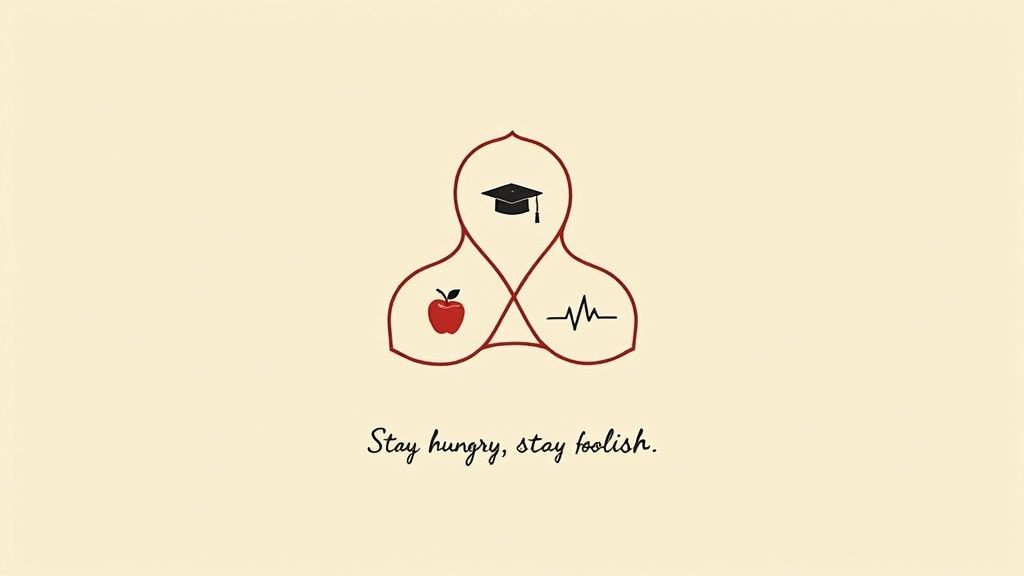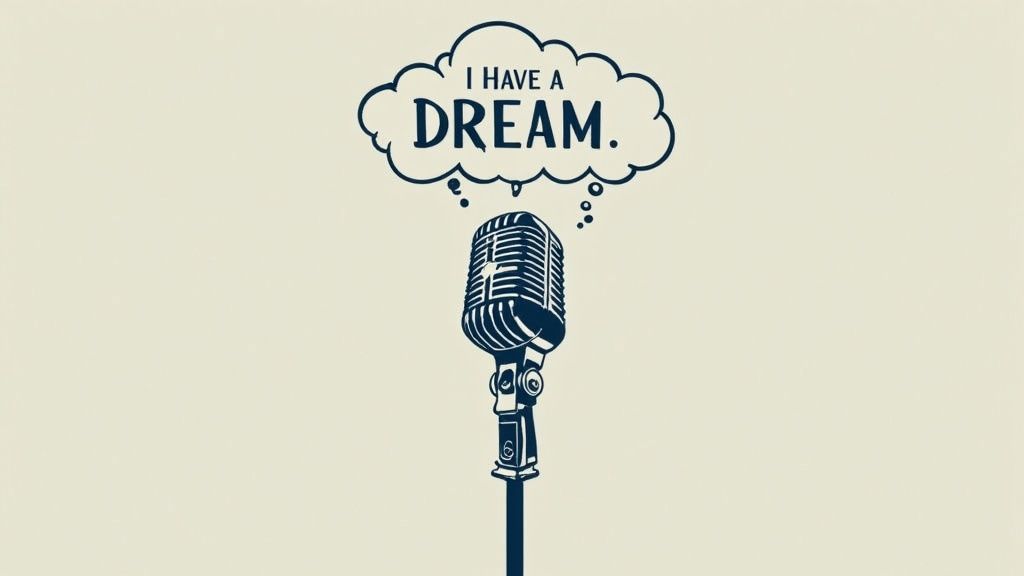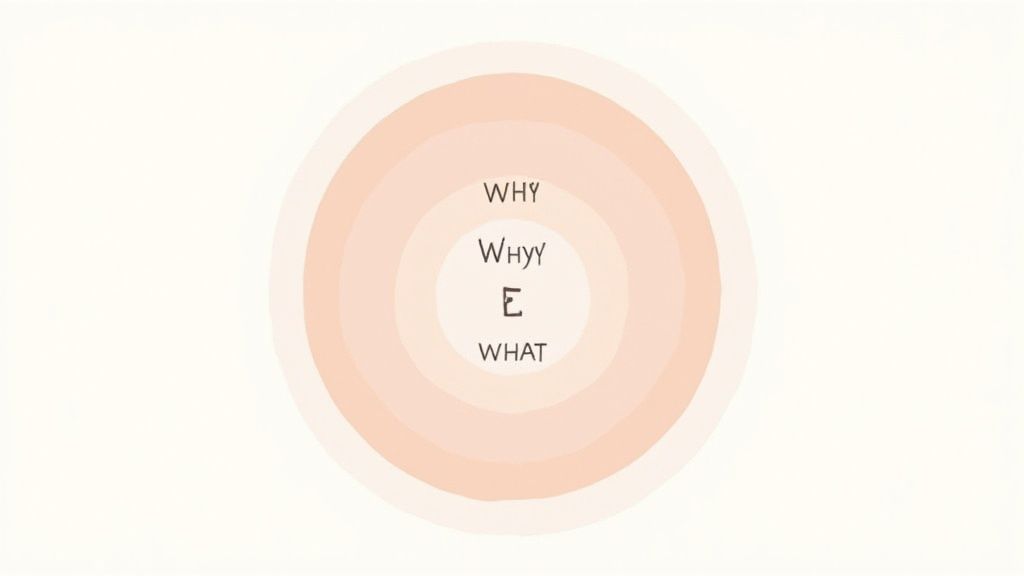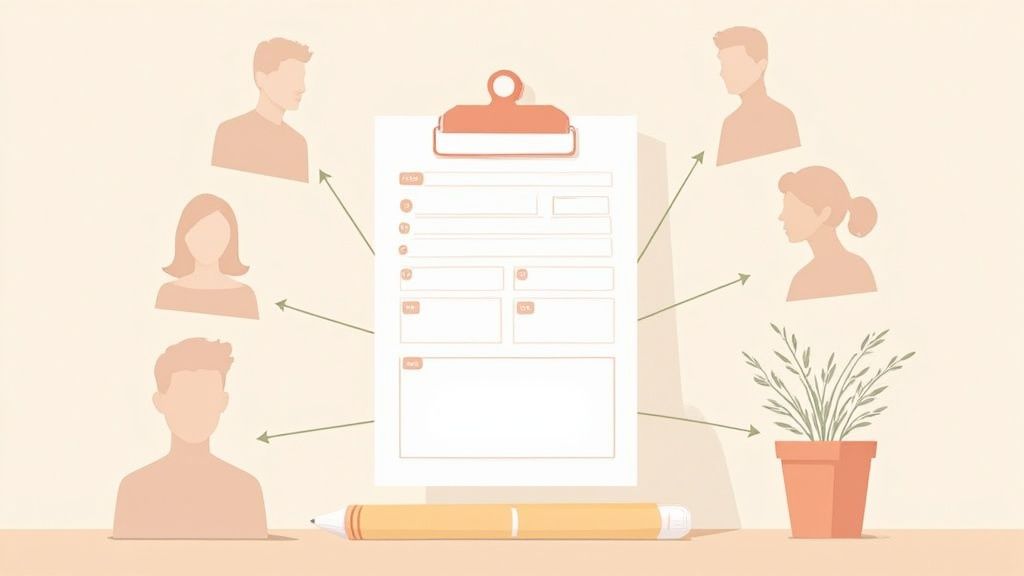Unlocking the Power of a Captivating Keynote
Want to deliver a keynote speech that truly resonates? This listicle showcases six powerful examples of a keynote speech, from iconic figures like Steve Jobs and Martin Luther King Jr. to contemporary thought leaders such as Brené Brown and Simon Sinek. Discover the elements of their success and learn how to craft your own compelling narrative. Whether you're a solopreneur building a brand, a creator finding your voice, or a career pivoter seeking direction, these examples offer invaluable lessons to inspire and empower your audience – and transform your presentations from ordinary to extraordinary.
1. Steve Jobs' 2005 Stanford Commencement Address
When seeking an example of a keynote speech that resonates deeply and leaves a lasting impact, look no further than Steve Jobs' 2005 address at Stanford University. This iconic speech stands as a testament to the power of personal narrative, vulnerability, and a clear, concise message. Jobs masterfully weaves together three seemingly disparate stories from his life – dropping out of college, being fired from Apple, and confronting a cancer diagnosis – to create a powerful and inspirational message about the importance of following your passion, finding meaning in life's setbacks, and living each day to the fullest. This isn't just a speech; it's a roadmap to navigating life's uncertainties and embracing the unknown. It's a prime example of a keynote speech done right, offering invaluable lessons for anyone seeking to connect with an audience on a profound level.

The magic of this speech lies in its simplicity. Jobs doesn't rely on complex jargon or technical details. Instead, he uses simple, direct language to convey profound ideas about life, death, and the pursuit of happiness. He structures his narrative around the "rule of three," sharing three distinct yet interconnected stories that build upon each other, culminating in a powerful conclusion. His authentic delivery, filled with natural pauses and emphasis, further strengthens the emotional connection with the audience.
This approach works because it’s deeply personal and relatable. Jobs’ willingness to share his vulnerabilities and struggles resonates with audiences on a human level, reminding us that even the most successful individuals face adversity. The speech's universal themes of perseverance, resilience, and the search for meaning appeal to a broad spectrum of individuals, from solopreneurs building their businesses to career pivoters seeking direction and purpose-driven professionals yearning for more meaningful work.
Features that make it an exemplary keynote speech:
- Three-part storytelling structure: Provides clarity and keeps the audience engaged.
- Personal narrative: Creates an emotional connection and builds trust.
- Motivational message: Inspires and empowers listeners to pursue their dreams.
- Simple, direct language: Makes the message accessible and easy to understand.
- Powerful conclusion: Leaves a lasting impression with the memorable phrase, "Stay hungry, stay foolish."
Pros:
- Exceptional emotional connection with the audience
- Memorable and quotable lines
- Authentic delivery
- Clear, concise messaging
- Universal themes that resonate widely
Cons:
- Highly personal approach may not work for all speakers
- Difficult to replicate its impact without similar life experiences
Examples of its impact:
- Over 40 million views on YouTube
- Regularly cited in public speaking courses
- Transcripts published in numerous books on leadership
Tips for incorporating elements of this speech into your own:
- Focus on authentic storytelling rather than technical details.
- Use simple language to convey profound ideas.
- Structure your speech around a clear rule of three.
- End with a memorable call to action or phrase.
- Practice delivering your speech with natural pauses and emphasis.
Popularized By: Steve Jobs, Apple, Stanford University, TED Talks platform (though not officially a TED Talk)
This speech deserves its place on this list because it exemplifies the power of storytelling, vulnerability, and authenticity in public speaking. It's a timeless example of a keynote speech that continues to inspire and motivate millions around the world. Whether you’re an aspiring creator seeking to find your voice, a coach looking to connect with clients, or a seasoned professional seeking to reignite your passion, Steve Jobs' Stanford address offers invaluable lessons on how to craft and deliver a truly impactful message.
2. Martin Luther King Jr.'s 'I Have a Dream' Speech
While not a business keynote in the traditional sense, Dr. King's "I Have a Dream" speech stands as a powerful example of a keynote speech, offering invaluable lessons for anyone seeking to inspire and motivate an audience. Delivered during the 1963 March on Washington for Jobs and Freedom, this address transcends its historical context to become a timeless example of persuasive oratory. It demonstrates how to articulate a vision, ignite passion, and galvanize action, making it a relevant study for anyone crafting their own keynote, particularly solopreneurs, creators, career pivoters, coaches, and purpose-driven professionals seeking to make a meaningful impact.

King masterfully weaves together rhetorical techniques, vivid imagery, and unwavering moral authority to paint a picture of racial equality and a unified America. This speech isn't just about historical context; it's a masterclass in connecting with an audience on an emotional level, a crucial element of any successful keynote speech example. Its enduring power lies in its ability to evoke hope, inspire change, and instill a sense of shared purpose. This is precisely what makes it so relevant for today's entrepreneurs and change-makers.
Features that make it a powerful example of a keynote speech:
- Powerful Repetition ("I have a dream"): This iconic phrase, repeated throughout the speech, became a rallying cry for the Civil Rights Movement. For any speaker, strategic repetition reinforces key messages and makes them memorable.
- Rich Metaphorical Language: King's use of metaphors, like "the sweltering summer of the Negro’s legitimate discontent," creates powerful mental images that resonate deeply with the audience.
- Rising Emotional Intensity: The speech builds momentum, moving from a statement of the problem to a soaring vision of the future, carrying the audience along on an emotional journey.
- Call to Action: While aspirational, the speech also implicitly calls for action, urging listeners to actively participate in the struggle for equality.
- Inclusive Vision: King's dream wasn't just for African Americans; it was a dream of a just and equitable society for all, creating a sense of shared purpose and collective responsibility.
Pros:
- Exceptional use of rhetorical devices makes the speech captivating and memorable.
- Strong moral framework provides a powerful foundation for the message.
- Beautiful, poetic language elevates the speech beyond mere rhetoric.
- Clear vision of the future inspires hope and motivates action.
- Perfect balance of problem and solution offers a pathway to change.
Cons:
- The historical context is specific and requires careful consideration when adapting its lessons to other settings, especially business.
- King's oratorical style requires exceptional speaking skills to emulate effectively.
Examples of its influence:
- Used as teaching material in public speaking courses worldwide.
- Analyzed in countless books on rhetoric and persuasion.
- Influenced political discourse for generations.
Tips for applying its principles to your keynote:
- Use metaphors that create clear mental images. Connect abstract concepts to concrete experiences.
- Build repetition of key phrases strategically. Reinforce your message and make it stick.
- Connect personal stories to universal themes. Make your message relatable and build emotional connection.
- Balance critique with hope and vision. Acknowledge challenges while inspiring a brighter future.
- Practice vocal modulation for emphasis. Vary your tone and pace to maintain audience engagement.
Popularized By: Dr. Martin Luther King Jr., the Civil Rights Movement, and the iconic setting of the Lincoln Memorial.
The "I Have a Dream" speech deserves its place on this list not because it's a typical business keynote, but because it exemplifies the power of inspirational speaking. By studying its features and applying its principles, anyone crafting an example of a keynote speech, particularly those seeking to drive change and build a movement around their purpose, can learn to connect with their audience on a deeper level and inspire action.
3. Brené Brown's TED Talk on Vulnerability: A Masterclass in Keynote Speaking
Brené Brown's TED Talk on vulnerability isn't just an example of a keynote speech; it's a revolution. It redefined the format, demonstrating the power of blending rigorous research with raw, personal storytelling. Brown, a research professor studying vulnerability, courage, shame, and empathy, bravely shares her own journey of breakdown and breakthrough. She unpacks complex research findings on human connection and presents them in an accessible, often humorous way that has resonated with millions worldwide. This approach transformed the landscape of keynote speaking, proving that vulnerability, authenticity, and connection are powerful tools for engagement and inspiration.

This talk's success stems from a potent combination of features. The research-backed content provides credibility, grounding Brown's personal experiences in scientific rigor. Her willingness to be vulnerable and embrace self-deprecating humor creates an instant connection with the audience, making her relatable and trustworthy. By using clear definitions and a storytelling framework, she makes abstract concepts like shame and vulnerability understandable and applicable to everyday life. This is a perfect example of a keynote speech that empowers its audience.
For solopreneurs, aspiring creators, career pivoters, coaches, and purpose-driven professionals, Brown's approach offers invaluable lessons. Her talk demonstrates how to build a powerful brand by owning your story, connecting authentically with your audience, and communicating complex ideas in a clear and compelling way. The success of her talk – over 60 million views, launching a global speaking career, spawning bestselling books – showcases the transformative potential of this approach. It provides a template for building a platform and connecting with a global audience.
Pros: The perfect balance of credibility and relatability, a transformative message that inspires behavioral change, an approachable delivery style, clear actionable insights, and memorable anecdotes.
Cons: The personal disclosure approach requires careful judgment in certain business contexts. The style depends heavily on the speaker's personality, and the casual approach may not be suitable for all professional environments.
Tips for Implementing this Approach:
- Start strong: Begin with a surprising research finding or statistic to capture attention.
- Find the balance: Balance data-driven insights with personal stories to create an emotional connection.
- Embrace humor: Use self-deprecating humor to build rapport and disarm the audience.
- Clarify complex concepts: Create clear definitions for abstract concepts, ensuring accessibility for everyone.
- End with a call to action: Challenge the audience to apply the insights to their own lives.
When to Use This Approach:
This approach is particularly effective when you want to inspire, connect with your audience on a deeper level, and drive behavioral change. It's ideal for presentations focused on personal development, leadership, overcoming challenges, or building strong communities. It's less suitable for highly technical presentations or situations requiring a formal, detached tone.
Brown's TED Talk deserves its place on this list because it embodies the best of what a keynote speech can be: informative, inspiring, and transformative. It's a testament to the power of vulnerability, authenticity, and human connection, offering a blueprint for anyone seeking to create a truly impactful keynote speech. You can watch her inspiring TED Talk here.
4. Simon Sinek's 'Start With Why' Golden Circle Keynote
Are you struggling to connect with your audience? Do you feel like your message is getting lost in the noise? Simon Sinek's "Start With Why" Golden Circle keynote offers a powerful example of a keynote speech that can transform how you communicate and inspire action. This revolutionary concept argues that truly inspirational leaders and organizations communicate from the inside out, starting with why they exist, then how they do it, and finally what they do. This is in contrast to most who start with what and work backward. This seemingly simple shift in perspective can have a profound impact on how your audience perceives and connects with your message.

Sinek illustrates the Golden Circle with compelling examples like Apple, Martin Luther King Jr., and the Wright Brothers. He demonstrates how these iconic figures and organizations tapped into a deeper sense of purpose, inspiring unwavering loyalty and driving remarkable success. Apple, for instance, doesn't just sell computers (what). They challenge the status quo and empower individuals with user-friendly technology (how) because they believe in thinking differently (why). This "why" resonates deeply with customers and fuels their brand loyalty.
Actionable Tips for Implementing "Start With Why":
- Identify Your "Why": Dig deep and uncover the core purpose that drives you. What is your ultimate belief? Why do you do what you do? For solopreneurs, this might be empowering others through your services. For aspiring creators, it could be sharing a unique perspective with the world. For career pivoters, it might be aligning your work with your values.
- Craft Your Message from the Inside Out: Once you've defined your "why," use it as the foundation for all your communication. Start by explaining your purpose, then describe how you achieve it, and finally, showcase what you offer.
- Use Powerful Storytelling: Like Sinek's examples of Apple and MLK, weave compelling narratives that illustrate your "why" in action. Stories resonate with audiences on an emotional level, making your message more memorable and impactful.
- Repeat Your Core Message: Reinforce your "why" throughout your keynote, using different examples and anecdotes to solidify its importance.
- Visualize Your "Why": Consider using a visual representation of your "why," similar to Sinek's Golden Circle, to enhance audience understanding and retention.
When and Why to Use "Start With Why":
This approach is incredibly versatile and can be applied across various contexts:
- Building a Brand: Differentiate yourself from the competition by communicating your unique purpose. This is particularly crucial for solopreneurs, consultants, and creators seeking to establish a strong brand identity.
- Inspiring Teams: Motivate your team by connecting them to a shared purpose. A clearly defined "why" fosters a sense of belonging and drives collective effort.
- Driving Sales: Connect with customers on a deeper level by appealing to their values and beliefs. This resonates powerfully with purpose-driven professionals and helps build lasting relationships.
- Leading Change: Inspire action and mobilize support for your vision by communicating the "why" behind the change.
Pros and Cons of the "Start With Why" Approach:
- Pros: Instantly applicable framework, memorable visual model, revolutionary yet simple concept, multiple real-world examples, clear structure.
- Cons: Model may oversimplify complex business dynamics, limited supporting research in the original presentation, can feel repetitive if not delivered effectively.
Sinek's "Start With Why" offers more than just an example of a keynote speech; it provides a blueprint for inspirational communication. By understanding and applying this powerful framework, you can connect with your audience on a deeper level, build a stronger brand, and ultimately achieve greater impact. His TED Talk, with over 60 million views, and subsequent book are testament to the enduring power of this concept. Whether you're a solopreneur, an aspiring creator, or a seasoned professional, "Start With Why" can empower you to communicate with clarity, purpose, and impact.
5. Sheryl Sandberg's 'Lean In' Keynote at TEDWomen: A Blueprint for Inspiring Change
Sheryl Sandberg's 2010 TEDWomen talk, "Why we have too few women leaders," is a prime example of a keynote speech that transcends the stage and sparks a movement. This presentation serves as a powerful blueprint for anyone seeking to use their voice to inspire change, whether you're a solopreneur carving a niche, a creator building a platform, a career pivoter defining a new path, a coach seeking to resonate with clients, or a professional yearning for deeper purpose. This keynote exemplifies how to deliver a message that resonates, motivates, and leaves a lasting impact. You can watch the talk here: https://www.ted.com/talks/sheryl_sandberg_why_we_have_too_few_women_leaders
Sandberg, then COO of Facebook, tackled the complex issue of gender inequality in the workplace. Her approach, blending compelling data with relatable personal anecdotes, created a powerful narrative that resonated deeply with audiences worldwide. This example of a keynote speech demonstrates the effectiveness of combining professional authority with personal vulnerability. She didn’t just present statistics; she shared her own struggles and triumphs, making her message both credible and inspiring. This keynote’s three-part structure provided clear, actionable advice: "sit at the table," "make your partner a real partner," and "don't leave before you leave." This simple, memorable framework helped translate complex research into practical steps for women navigating their careers.
Features that make this an exceptional example of a keynote speech:
- Data-driven arguments: Sandberg uses statistics to highlight the disparity in leadership roles, grounding her arguments in solid evidence.
- Personal storytelling: Sharing her own experiences makes her relatable and builds a connection with the audience.
- Three-part structure with clear advice: The simple framework allows the audience to easily grasp and remember the key takeaways.
- Addressing controversial topics with nuance: She acknowledges the complexities of the issue, recognizing that no single solution fits all situations.
- Call to action directed at multiple stakeholders: Sandberg's message resonates not only with women but also with men and organizations, fostering a broader conversation.
Pros:
- Balances statistics with storytelling: The combination of data and personal narrative makes the message both compelling and relatable.
- Addresses counter-arguments directly: Sandberg anticipates and addresses potential criticisms, strengthening her argument.
- Offers clear, actionable advice: The three-part framework empowers the audience with practical steps they can take.
- Creates a movement beyond the talk itself: This keynote sparked a global movement, demonstrating its enduring impact.
- Combines professional authority with personal vulnerability: This blend of credibility and relatability strengthens her message.
Cons:
- Some criticism for focusing on individual rather than systemic solutions: While empowering, some argue the focus on individual actions overlooks the need for broader societal change.
- Advice may not be universally applicable across cultural contexts: The advice provided may not be equally relevant or feasible in all cultures and work environments.
- Complex social issues necessarily simplified for keynote format: The limitations of the keynote format require simplifying complex issues, which can sometimes lead to oversimplification.
Tips inspired by Sandberg's approach:
- Support controversial points with solid research: Data lends credibility to your arguments.
- Share personal failures along with successes: Vulnerability builds connection and makes your message more relatable.
- Offer specific, actionable advice: Empower your audience with practical steps they can implement.
- Address potential criticisms directly: Anticipating and addressing criticisms head-on strengthens your message.
- Consider how your keynote could spawn ongoing initiatives: Think beyond the stage – how can your message create lasting change?
Sheryl Sandberg's "Lean In" keynote exemplifies how a powerful speech can become a catalyst for change. This example of a keynote speech provides invaluable lessons for anyone seeking to use their voice to make a difference, regardless of their field or platform. By blending data with personal narrative, offering clear advice, and addressing complex issues with nuance, you too can craft a message that resonates, inspires, and creates a ripple effect of positive change.
6. Tony Robbins' Motivational Keynote Framework
Looking for an example of a keynote speech that truly ignites the stage and leaves a lasting impact? Look no further than Tony Robbins' motivational keynote framework. This dynamic approach goes beyond simply delivering information; it's about creating a transformative experience for your audience. If you're a solopreneur seeking to differentiate, an aspiring creator searching for your voice, a career pivoter needing direction, a coach yearning to attract the right clients, or a purpose-driven professional craving deeper meaning, understanding this framework can revolutionize how you connect with your audience.
This method is characterized by high energy, audience participation, and a focus on personal transformation. Robbins masterfully weaves together personal stories, strategic metaphors, and powerful music to create an immersive experience. Unlike conventional keynotes, Robbins' presentations often run for 3-4 hours, demonstrating his commitment to fostering immediate emotional and behavioral shifts in his participants. His keynotes are less about conveying information and more about facilitating change.
How it Works:
The Robbins framework leverages several key features:
- High Physical Energy and Movement: Robbins' dynamic stage presence keeps the audience engaged and energized.
- Audience Participation and Exercises: He actively involves the audience through interactive exercises designed to create immediate "wins" and solidify learning.
- Personal Stories of Transformation: Sharing relatable stories creates connection and inspires hope.
- Pattern Interrupts and State Changes: Shifts in tone, volume, and activities keep the audience mentally present and emotionally charged.
- Metaphors and Analogies: These tools simplify complex ideas and make them memorable.
- Strategic Use of Music and Environment: Carefully curated music and lighting enhance the emotional impact of the message.
Examples of Successful Implementation:
- Date With Destiny seminars: These immersive multi-day events delve deep into personal development.
- Business Mastery keynotes: Robbins empowers entrepreneurs with strategies for achieving peak performance.
- TED Talk on 'Why we do what we do': This widely viewed talk offers a glimpse into Robbins' motivational techniques.
- Netflix documentary 'I Am Not Your Guru': Provides a behind-the-scenes look at the intensity and impact of his events.
Actionable Tips for Incorporating the Robbins Approach into Your Own Keynote Speeches:
- Create physical "state breaks": Introduce movement and shifts in energy to maintain audience engagement during longer presentations.
- Use questions: Engage your audience mentally by asking thought-provoking questions.
- Develop signature stories: Craft compelling narratives that illustrate your key points and resonate with your target audience.
- Design exercises that create immediate wins: Give your audience tangible takeaways they can implement immediately.
- Vary vocal tone, pace, and volume dramatically: Create emotional impact and maintain attention through dynamic vocal delivery.
Pros:
- Creates memorable emotional experiences: Attendees leave feeling inspired and empowered.
- Drives immediate behavioral change: The interactive nature of the framework encourages action.
- Builds extraordinary audience engagement: Participants are actively involved throughout the presentation.
- Memorable catchphrases and concepts: Robbins' presentations are filled with quotable moments that stick with the audience long after the event.
- Combines entertainment with education: Learning becomes an engaging and enjoyable experience.
Cons:
- Length requires exceptional audience management skills: Sustaining energy and focus for extended periods requires expertise.
- Physically demanding delivery style: This approach requires significant stamina and preparation.
- May feel inauthentic if adopted without genuine passion: Authenticity is key to effectively delivering this style of keynote.
- Format can overshadow content for some audiences: The high-energy style can sometimes distract from the core message.
- Style may be too intense for conservative business settings: Consider your audience and context when deciding whether to adopt this approach.
Why This Approach Deserves its Place in the List:
The Tony Robbins motivational keynote framework stands out as an example of a keynote speech that truly transforms. It's not just about imparting information; it's about igniting passion, inspiring action, and creating lasting change. While this high-energy approach may not be suitable for every context, its effectiveness in creating memorable and impactful experiences makes it a powerful model for anyone seeking to connect with their audience on a deeper level. For those looking to break away from conventional presentations and create a truly transformative experience, studying and adapting elements of the Robbins framework can provide a valuable roadmap to success.
Keynote Speech Comparison Overview
| Keynote Speech | 🔄 Implementation Complexity | 📊 Resource Requirements | ⭐ Expected Outcomes | 💡 Ideal Use Cases | ⚡ Key Advantages |
|---|---|---|---|---|---|
| Steve Jobs' 2005 Stanford Commencement | Moderate — structured storytelling | Low — personal narrative and simple language | High — emotional connection, lasting impact | Inspirational events, graduation, leadership talks | Authenticity, memorable quotes, universal themes |
| MLK Jr.'s "I Have a Dream" Speech | High — requires exceptional oratory | Low — speech-focused, no props | Exceptional — ignites social movements | Social justice, motivational, historical commemorations | Powerful rhetoric, moral authority, vivid imagery |
| Brené Brown's TED Talk on Vulnerability | Moderate — blending research & storytelling | Medium — data integration and personal stories | High — behavioral change, emotional connection | Academic, corporate culture, self-improvement talks | Research credibility, relatable storytelling |
| Simon Sinek's "Start With Why" Keynote | Low to Moderate — simple framework | Low — visual aids and examples | High — practical business application | Business leadership, marketing, organizational change | Clear model, applicability, memorable visuals |
| Sheryl Sandberg's "Lean In" TEDWomen Keynote | Moderate — data + storytelling + nuanced topics | Medium — research and personal anecdotes | High — sparks social movements and policy discussion | Gender equality, corporate training, social issues | Balanced argumentation, actionable advice |
| Tony Robbins' Motivational Keynote | High — long, high-energy, participatory | High — extensive preparation, engagement tools | Very High — immediate behavioral change | Personal development, large conferences, transformational events | Audience engagement, emotional impact, experiential |
Crafting Your Own Keynote Masterpiece
From Steve Jobs' captivating storytelling to Brené Brown's raw vulnerability, the examples of a keynote speech we've explored demonstrate the power of this medium to inspire, educate, and motivate. Remember the key takeaways: a clear message, authentic delivery, a compelling narrative, and a deep understanding of your audience. Whether you're a solopreneur seeking to differentiate your brand, a creator finding your voice, or a purpose-driven professional yearning for deeper meaning, mastering these principles can transform your presentations from good to unforgettable. By internalizing the lessons from these keynote giants, you're not just building speaking skills; you're cultivating the power to connect, influence, and leave a lasting impact on the world.
Ready to craft a keynote that truly reflects your unique voice and vision? Henri Den provides the tools and guidance to hone your message and amplify your presence. Visit Henri Den today and unlock your potential to become a truly captivating keynote speaker.






